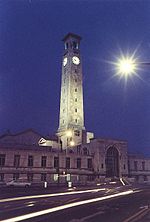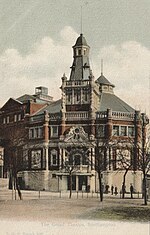Southampton Cenotaph

Southampton Cenotaph is a First World War memorial designed by Sir Edwin Lutyens and located in Watts Park in the southern English city of Southampton. The memorial was the first of dozens by Lutyens to be built in permanent form and it influenced his later designs, including the Cenotaph in London. It is a tapering, multi-tiered pylon which culminates in a series of diminishing layers before terminating in a sarcophagus (or cenotaph, 'empty tomb') which features a recumbent figure of a soldier. In front is an altar-like Stone of Remembrance. The cenotaph contains multiple sculptural details including a prominent cross, the town's coat of arms, and two lions. The names of the dead are inscribed on three sides. Although similar in outline, later cenotaphs by Lutyens were much more austere and featured almost no sculpture. The design uses abstract, ecumenical features and lifts the recumbent soldier high above eye level, anonymising him. The memorial was unveiled at a public ceremony on 6 November 1920. Shortly afterwards, concerns emerged that the list of names on the cenotaph was incomplete. After a newspaper campaign, more than 200 further names were identified and these were eventually added to the cenotaph. The names of most Jewish casualties were omitted, the Jewish community being unhappy that the memorial featured a Christian cross. By the beginning of the 21st century, the engravings on the memorial had deteriorated noticeably. Rather than re-cut them and damage the stonework, they were supplemented by a series of glass panels that bear all the names from the cenotaph, as well as names from the Second World War and later conflicts. The panels were unveiled in 2011. The memorial is a Grade I listed building, having been upgraded in 2015 when Lutyens's war memorials were declared a national collection.
Excerpt from the Wikipedia article Southampton Cenotaph (License: CC BY-SA 3.0, Authors, Images).Southampton Cenotaph
Above Bar Street, Southampton The Polygon
Geographical coordinates (GPS) Address External links Nearby Places Show on map
Geographical coordinates (GPS)
| Latitude | Longitude |
|---|---|
| N 50.909666666667 ° | E -1.4051666666667 ° |
Address
The Cenotaph
Above Bar Street
SO14 7DW Southampton, The Polygon
England, United Kingdom
Open on Google Maps









